Widescreen Weekend 2014 |
Read more at in70mm.com The 70mm Newsletter |
| Written and photographed by: Mark Trompeteler. All photos by the author with many thanks to The National Media Museum Press Office. | Date: 02.09.2014 |
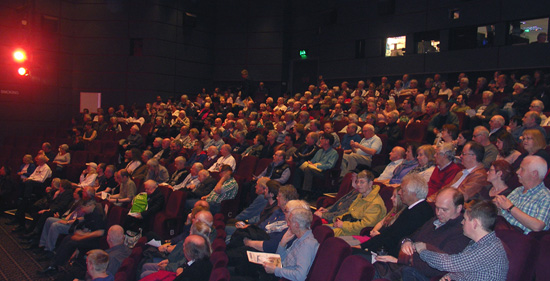 Once again the Widescreen Weekend event took place earlier this year at
the National Media Museum in Bradford. Delegates travelled from across
the world to enjoy this celebration of all things widescreen in mid
April. This year, it took place a week after the main part of the
Bradford International Film Festival had finished, to which the weekend
is very closely allied. Once again the Widescreen Weekend event took place earlier this year at
the National Media Museum in Bradford. Delegates travelled from across
the world to enjoy this celebration of all things widescreen in mid
April. This year, it took place a week after the main part of the
Bradford International Film Festival had finished, to which the weekend
is very closely allied.In what may seem an increasingly challenging climate of national budget cuts for galleries and museums, and alternative widescreen festivals in Europe taking place around the same time as Bradford’s weekend – this year’s event had its challenges to face. Potential delegates residing in central and eastern Europe had the difficult choice, of potentially attending Bradford or a 70mm focused festival based in the Mir 70 cinema in Krnov in the Czech Republic. |
More in 70mm reading: Widescreen Weekend, Bradford, England Cinerama Birthday Bradford Celebrates Cinerama’s 60th. Anniversary Widescreen Weekend 2013 Internet link: |
A Loyal Audience |
|
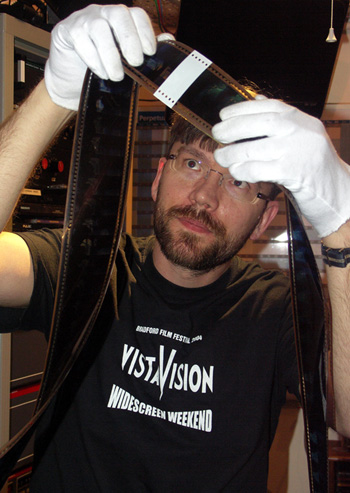 Exchange
Projectionist Joop DeGruiter Exchange
Projectionist Joop DeGruiterOn arrival I learned that 125 core delegates had registered for the weekend, which compared to some of the delegate registrations in the past, seemed a good number. One always hopes that events like this will be supported and continued in these challenging times. Even post the all time record for delegates attending the Widescreen Weekend in 2012 for the "Cinerama is 60" celebrations, the fact that there was a core of 125 delegates registering this year seemed to indicate a couple of things to me. Firstly, that there are many international widescreen fans still prepared to continue to support this event and that secondly the way programming this event has developed is obviously still striking a chord with the event’s potential audience. In an interview as part of a short film shown during the weekend, Bill Lawrence, the founder of this event, stated how surprised and very pleased he is that this event still continues to be enthusiastically supported by international delegates. Very attractive and effective changes which had been made to the main museum cafe and the Pictureville bar and foyer greeted delegates on arrival. Whilst catering and drinks facilities had not been compromised there had been a very effective increase in the amount of comfortable seating and small tables available – the kind of adaptations that facilitate not only eating and drinking but networking and socialising and as a destination to arrange a meeting with someone – something that BFI Southbank in London has so effectively utilised. It was good to see these adaptations being so well used. On the opening Thursday evening of the long weekend the professional tone of the whole weekend was set both by an animated “ident” for the weekend and a superbly assembled and cut compilation of the weekend’s highlights produced by projection team member, Tom Perkins. In his opening address Duncan McGregor, Widescreen Weekend programmer, talked about last year’s event as being a turning point in their programming policy, based on feedback they had received from delegates. The policy was now one of not longer showing very poor colour prints of classic widescreen films, where the dyes had largely faded to just a pink / “magentavison” print, when an acceptable good standard full colour digital version of that film is now available. Whilst still a controversial policy decision for a few of the delegates, it was good to see the number of delegate numbers being maintained steadily over the past few years, so it is hardly a policy decision disliked by the many. |
|
Things White & Blue |
|
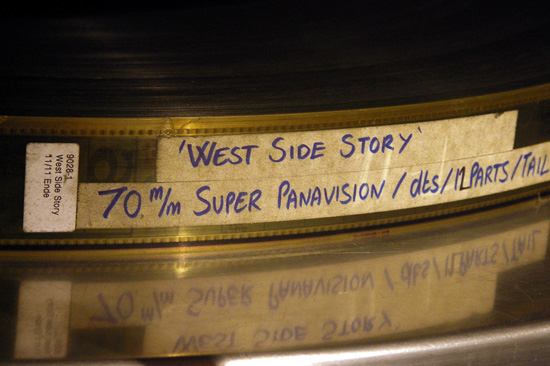 The weekend commenced with the showing of a 2K DCP in 1.85:1 on the flat
screen of the 1954 Michael Curtiz film “White Christmas”. It was being
screened to celebrate the 60th anniversary of Paramount’s “high
fidelity” film process VistaVision – one of the large format widescreen
processes Hollywood developed as a result of the impact of Cinerama and
subsequently Cinemascope. This process involved passing standard 35mm
film through the camera horizontally and not vertically – it utilised
full frame 35mm film in both image capture and image projection –
doubling the amount of image resolution and quality. An excellent
introduction by film historian
Tony Sloman highlighted that two previous
“outings” of the highly successful song “White Christmas” had occurred
in the films “Holiday Inn” and “Blue Skies”. The DCP gave justice to the
rich vibrant colours of the Technicolour process and even at 2K the
detail and crispness in the close ups was more than seductive as
compared to the close ups when seen projected from traditional film
prints. However in wider shots 2K DCPs of classic films can still
sometimes disappoint. The weekend commenced with the showing of a 2K DCP in 1.85:1 on the flat
screen of the 1954 Michael Curtiz film “White Christmas”. It was being
screened to celebrate the 60th anniversary of Paramount’s “high
fidelity” film process VistaVision – one of the large format widescreen
processes Hollywood developed as a result of the impact of Cinerama and
subsequently Cinemascope. This process involved passing standard 35mm
film through the camera horizontally and not vertically – it utilised
full frame 35mm film in both image capture and image projection –
doubling the amount of image resolution and quality. An excellent
introduction by film historian
Tony Sloman highlighted that two previous
“outings” of the highly successful song “White Christmas” had occurred
in the films “Holiday Inn” and “Blue Skies”. The DCP gave justice to the
rich vibrant colours of the Technicolour process and even at 2K the
detail and crispness in the close ups was more than seductive as
compared to the close ups when seen projected from traditional film
prints. However in wider shots 2K DCPs of classic films can still
sometimes disappoint.Thursday evening’s second film was the 1988 Luc Besson’s “The Big Blue” originally shot in 35 mm anamorphic. What was screened was a 70 mm blow up shown in 2.20.1 on the flat screen. This was the first time I had ever seen this film and its captivating theme of a man whose soul is captured by a love of the sea, dolphins and the power of “the big blue” is a precursor to the many amazing explorations of narrative, subject matter and theme that are explored in mainstream world cinema today. To see film prints and DCPs almost straight after each other, as now happens at this event, is always so instructive at how film exhibition has evolved and developed. The very minor imperfections of some minor scratching and minor jumps in the image were more than compensated by the beautiful tonal gradation, resolution and film quality of this print. I thought it was one of the more successful 70 mm blow ups I have seen for awhile. |
|
Three Strip Paradise |
|
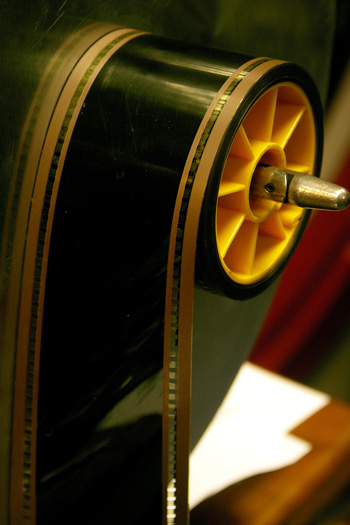 For enthusiasts of widescreen film on a deeply curved screen and those
following the progress of the crusade to digitally
preserve the legacy
of the Cinerama travelogues, delegates were delighted by the return of
Hollywood cineastes
Dave Strohmaier and
Randy Gitsch to Widescreen
Weekend – now for the eighth time. They were accompanied by
Tom March,
who has done much too in the campaign to preserve and publicise the
contribution that three strip Cinerama made to the history of the
cinema. For enthusiasts of widescreen film on a deeply curved screen and those
following the progress of the crusade to digitally
preserve the legacy
of the Cinerama travelogues, delegates were delighted by the return of
Hollywood cineastes
Dave Strohmaier and
Randy Gitsch to Widescreen
Weekend – now for the eighth time. They were accompanied by
Tom March,
who has done much too in the campaign to preserve and publicise the
contribution that three strip Cinerama made to the history of the
cinema.Friday Morning saw the European première of the digital remaster of the 1956 film “Seven Wonders of the World” introduced by Dave, with the European première of the digital remaster of the 1957 film “Search for Paradise” taking place on the Saturday introduced by Randy. A Powerpoint presentation produced by David Coles from Australia giving a detailed background to the context of the making of “Search for Paradise” preceded the film’s screening. Both films originally shot in the Cinerama three strip process were presented on the curved screen from 2K DCPs. It was particularly noticeable for the “Seven Wonders of the World” première that the auditorium was three quarters full, indication that a significant number of non delegates had purchased tickets to see this première on a weekday morning. Dave asked for a show of hands in the audience and this indicated that an overwhelming proportion of the audience had never ever seen the film before – an interesting point of note as to the curiosity of the audience to see what Cinerama is about or the curiosity of the audience about large screen exhibition formats? Dave spoke of his restoration work on this title and how the emulsion was almost beginning to peel away from the base stock, that some 300 instances of the use of mattes had to be utilised to overcome flicker and fading problems with shots, and how that some degree of future proofing had been built into the restoration by utilising a 3K scan of each of the three panels. Thus 9Ks worth of digital file information was being filed and stored by themselves and Cinerama and also copied to the Library of Congress for the preservation of the title and for any possible adaptation to any future digital formats. Watching “Search for Paradise” on the Saturday, I was again so struck by how much visual information Cinerama presented to the viewer and how good the technical quality of that information could be potentially. The disappointment mentioned above I get from the “look” of wider shots in 2K DCPs in quite a few 35mm film transfers was just not occurring with this 2K DCP file of the original three strips that made up “Search for Paradise”. The detail in the very frequent panoramic long shots and medium shots didn’t disappoint in the way that the 2K digitisation of conventional films still does. Dave Strohmaier and Randy Gitsch together with associates like Tom March have achieved a truly amazing legacy of restoration on miniscule budgets. In the traditional Sunday morning programming slot of “Cineramacana” enthusiasts were able to see a three strip film screening of a relatively new print of the “How The West Was Won” trailer and also a restoration of the three strip Renault advertisement. |
|
Blow Ups Galore |
|
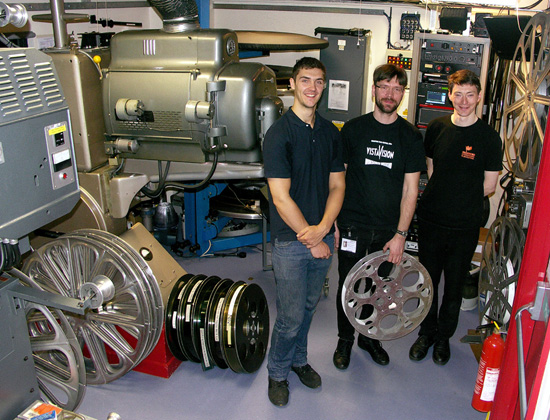 I personally have never been a great fan of “blow ups” of films shot on
35mm to 70 mm prints but this year my dislike was changed. Following the
70 mm blow up of “The Big Blue” on the first night – the weekend went on
to present 70 mm blow up prints of the 1986 John Carpenter film “Big
Trouble in Little China” originally shot in 35mm Panavision anamorphic
and presented in 70 mm on the flat screen in 2.20:1 - a very good 70 mm
print. The 1984 film “City Heat” with Burt Reynolds and Clint Eastwwod,
original format 35mm 1.85:1, was presented in the same aspect ratio in
70mm on the flat screen. Also “Terminator 2: Judgement Day” the 1991
James Cameron film, which was a significant step in the further
development of modern special effects techniques, original format being
Super 35 2.35:1 was shown in a 70mm blow up in 2.20 on the flat screen.
The 70 mm blow up print was excellent, rich in naturalistic and dramatic
colour, with a crisp and detailed quality and contrast ratio that
showcased the silver bromide photographic film technology as the
stunning process that it is. It was a fabulous 70 mm blow up print. The
superb visual quality of the print brilliantly complemented the dramatic
action, special effects and more general visual power of the film
itself. I personally have never been a great fan of “blow ups” of films shot on
35mm to 70 mm prints but this year my dislike was changed. Following the
70 mm blow up of “The Big Blue” on the first night – the weekend went on
to present 70 mm blow up prints of the 1986 John Carpenter film “Big
Trouble in Little China” originally shot in 35mm Panavision anamorphic
and presented in 70 mm on the flat screen in 2.20:1 - a very good 70 mm
print. The 1984 film “City Heat” with Burt Reynolds and Clint Eastwwod,
original format 35mm 1.85:1, was presented in the same aspect ratio in
70mm on the flat screen. Also “Terminator 2: Judgement Day” the 1991
James Cameron film, which was a significant step in the further
development of modern special effects techniques, original format being
Super 35 2.35:1 was shown in a 70mm blow up in 2.20 on the flat screen.
The 70 mm blow up print was excellent, rich in naturalistic and dramatic
colour, with a crisp and detailed quality and contrast ratio that
showcased the silver bromide photographic film technology as the
stunning process that it is. It was a fabulous 70 mm blow up print. The
superb visual quality of the print brilliantly complemented the dramatic
action, special effects and more general visual power of the film
itself. |
|
70mm Splendour |
|
|
Films shot in 70 mm were represented by “West Side Story” and
“It’s a
Mad Mad Mad Mad World” as well as a Strohmaier restoration of the Oscar
nominated 1964 short subject “Fortress of Peace” originally shot in
MCS-70 Super Panorama. The original format of “IAMMMMW” was the later
single lens “Super Cinerama” Ultra Panavison 70 photographic process and
it was presented in 70mm in 2.20:1 on the curved screen. One of my
favorite parts of widescreen weekend is an evening screening of one of
the great big 65mm / 70mm widescreen “roadshow” movies being shown via a
good 70mm print with all the presentation trimmings of overture,
intermission music etc., and to a full house. Although shown a few years
ago at Widescreen Weekend “West Side Story” in 70mm attracted sufficient
numbers of local cinemagoers to add to the core weekend delegates to
fill the auditorium yet again. The film was introduced by Wolfram Hannemann who made special reference to the film director’s and
distributor’s original request to cinemas on how to correctly exhibit
the fantastic overture sequence to this film. The director
Robert Wise,
was aware that in exhibiting “roadshow” movies, cinemas played the
overture music with the screen curtains closed and the house lights
fully on. He did not want the fidelity of the overture music to this
film compromised or part muffled by closed curtains and he couldn’t show
a blank screen if the curtains were open for the overture. He asked Saul
Bass, the brilliant titles designer, to produce an abstract image that
could be projected as the overture played. The instructions sent out
with the prints at the time specified that the curtains should open and
the abstract image be projected onto the screen with the house lights
dimmed to 75% brightness during most of the overture, so that the
audience would realise that this was the overture and that the film had
not yet. The instructions specified at which exact point the lights
should be dimmed fully to display that unforgettable and brilliant few
seconds when the abstract image dissolves into to the start of the film.
This audio visual “tour de force” of this overture transition is one of
the great moments in the history of cinema exhibition. Hannemann set the
projection team the task of following Wise’s instructions and they
delivered the showing of the overture as it should be shown - it was the
start of another fabulous 70 mm screening at Bradford – which is part of
what makes these annual weekends so special. |
|
A Great Weekend |
|
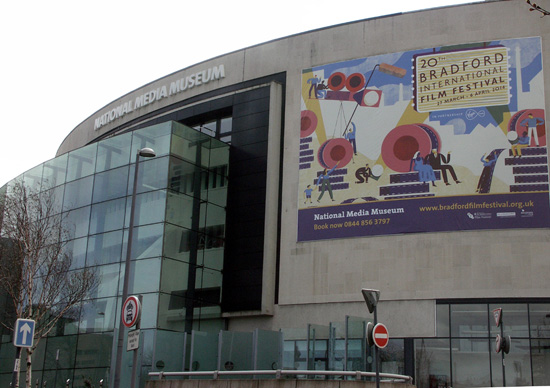 Other events and screenings during this weekend included the first ever
BKSTS / National Media Museum Student Widescreen Film of the Year
competition which showcased six short widescreen films produced by
students on BKSTS accredited courses. Professor Sir Christopher Frayling
gave an illustrated presentation on “The Widescreen Aesthetics of Sergio
Leone” followed by the screening of a 35 mm print of “For A Few Dollars
More”. Wolfram Hannemann showed his delightful short film “Remembering
Widescreen”, and there was a screening of a 4K DCP of the 1973 Sydney
Pollack film “The Way We Were”. Other events and screenings during this weekend included the first ever
BKSTS / National Media Museum Student Widescreen Film of the Year
competition which showcased six short widescreen films produced by
students on BKSTS accredited courses. Professor Sir Christopher Frayling
gave an illustrated presentation on “The Widescreen Aesthetics of Sergio
Leone” followed by the screening of a 35 mm print of “For A Few Dollars
More”. Wolfram Hannemann showed his delightful short film “Remembering
Widescreen”, and there was a screening of a 4K DCP of the 1973 Sydney
Pollack film “The Way We Were”. This year’s Widescreen Weekend was well attended with, as always, a busy schedule. It was good to see local cinemagoers coming in to create a few “full houses” or near “full houses” for a number of the screenings. With its now established policy of providing a seamless integration between showing film prints and DCPs, the absence of faded “magentavision” prints and programming intervals that provide sufficient time for meals, refreshments, socialising and networking – it’s a formula that delegates seem to really enjoy. Congratulations to the whole film festival and projection team at Bradford. As always delegates will be looking out for advance notification of next year’s weekend from next January onwards. If you haven’t experienced the wonderful world of the Widescreen Weekend yet – I thoroughly recommend that you do. |
|
| Go: back - top - back issues - news index Updated 22-01-25 |
